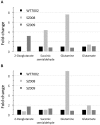Natural and Synthetic Variants of the Tricarboxylic Acid Cycle in Cyanobacteria: Introduction of the GABA Shunt into Synechococcus sp. PCC 7002
- PMID: 28018308
- PMCID: PMC5160925
- DOI: 10.3389/fmicb.2016.01972
Natural and Synthetic Variants of the Tricarboxylic Acid Cycle in Cyanobacteria: Introduction of the GABA Shunt into Synechococcus sp. PCC 7002
Abstract
For nearly half a century, it was believed that cyanobacteria had an incomplete tricarboxylic acid (TCA) cycle, because 2-oxoglutarate dehydrogenase (2-OGDH) was missing. Recently, a bypass route via succinic semialdehyde (SSA), which utilizes 2-oxoglutarate decarboxylase (OgdA) and succinic semialdehyde dehydrogenase (SsaD) to convert 2-oxoglutarate (2-OG) into succinate, was identified, thus completing the TCA cycle in most cyanobacteria. In addition to the recently characterized glyoxylate shunt that occurs in a few of cyanobacteria, the existence of a third variant of the TCA cycle connecting these metabolites, the γ-aminobutyric acid (GABA) shunt, was considered to be ambiguous because the GABA aminotransferase is missing in many cyanobacteria. In this study we isolated and biochemically characterized the enzymes of the GABA shunt. We show that N-acetylornithine aminotransferase (ArgD) can function as a GABA aminotransferase and that, together with glutamate decarboxylase (GadA), it can complete a functional GABA shunt. To prove the connectivity between the OgdA/SsaD bypass and the GABA shunt, the gadA gene from Synechocystis sp. PCC 6803 was heterologously expressed in Synechococcus sp. PCC 7002, which naturally lacks this enzyme. Metabolite profiling of seven Synechococcus sp. PCC 7002 mutant strains related to these two routes to succinate were investigated and proved the functional connectivity. Metabolite profiling also indicated that, compared to the OgdA/SsaD shunt, the GABA shunt was less efficient in converting 2-OG to SSA in Synechococcus sp. PCC 7002. The metabolic profiling study of these two TCA cycle variants provides new insights into carbon metabolism as well as evolution of the TCA cycle in cyanobacteria.
Keywords: 2-oxoglutaric acid; GABA shunt; Synechococcus sp. PCC 7002; Synechocystis sp. PCC 6803; TCA cycle; cyanobacteria; photosynthesis; succinic acid semialdehyde.
Figures






Similar articles
-
Disruption of cyanobacterial γ-aminobutyric acid shunt pathway reduces metabolites levels in tricarboxylic acid cycle, but enhances pyruvate and poly(3-hydroxybutyrate) accumulation.Sci Rep. 2019 Jun 3;9(1):8184. doi: 10.1038/s41598-019-44729-8. Sci Rep. 2019. PMID: 31160681 Free PMC article.
-
The γ-aminobutyric acid shunt contributes to closing the tricarboxylic acid cycle in Synechocystis sp. PCC 6803.Mol Microbiol. 2014 Aug;93(4):786-96. doi: 10.1111/mmi.12699. Epub 2014 Jul 16. Mol Microbiol. 2014. PMID: 24989231
-
The tricarboxylic acid cycle in cyanobacteria.Science. 2011 Dec 16;334(6062):1551-3. doi: 10.1126/science.1210858. Science. 2011. PMID: 22174252
-
How and why does tomato accumulate a large amount of GABA in the fruit?Front Plant Sci. 2015 Aug 10;6:612. doi: 10.3389/fpls.2015.00612. eCollection 2015. Front Plant Sci. 2015. PMID: 26322056 Free PMC article. Review.
-
Inherited disorders of GABA metabolism.J Inherit Metab Dis. 1993;16(4):704-15. doi: 10.1007/BF00711902. J Inherit Metab Dis. 1993. PMID: 8412016 Review.
Cited by
-
Engineering photosynthetic production of L-lysine.Metab Eng. 2017 Nov;44:273-283. doi: 10.1016/j.ymben.2017.10.010. Epub 2017 Oct 28. Metab Eng. 2017. PMID: 29111438 Free PMC article.
-
A Metabolic Network Mediating the Cycling of Succinate, a Product of ROS Detoxification into α-Ketoglutarate, an Antioxidant.Antioxidants (Basel). 2022 Mar 16;11(3):560. doi: 10.3390/antiox11030560. Antioxidants (Basel). 2022. PMID: 35326210 Free PMC article.
-
Cyanobacterial carboxysome mutant analysis reveals the influence of enzyme compartmentalization on cellular metabolism and metabolic network rigidity.Metab Eng. 2019 Jul;54:222-231. doi: 10.1016/j.ymben.2019.04.010. Epub 2019 Apr 25. Metab Eng. 2019. PMID: 31029860 Free PMC article.
-
Kinetics of the ancestral carbon metabolism pathways in deep-branching bacteria and archaea.Commun Chem. 2021 Oct 22;4(1):149. doi: 10.1038/s42004-021-00585-0. Commun Chem. 2021. PMID: 36697601 Free PMC article.
-
Disruption of cyanobacterial γ-aminobutyric acid shunt pathway reduces metabolites levels in tricarboxylic acid cycle, but enhances pyruvate and poly(3-hydroxybutyrate) accumulation.Sci Rep. 2019 Jun 3;9(1):8184. doi: 10.1038/s41598-019-44729-8. Sci Rep. 2019. PMID: 31160681 Free PMC article.
References
LinkOut - more resources
Full Text Sources
Other Literature Sources
Molecular Biology Databases
Research Materials
Miscellaneous

